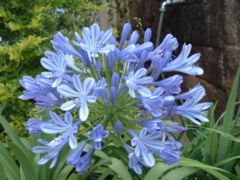Agapanthus africanus
Agapanthus africanus {{{latin_name}}}
|
African blue lily
| ||||||||||||||||||||||||||||||||||||||||
|---|---|---|---|---|---|---|---|---|---|---|---|---|---|---|---|---|---|---|---|---|---|---|---|---|---|---|---|---|---|---|---|---|---|---|---|---|---|---|---|---|---|

|
|
| |||||||||||||||||||||||||||||||||||||||
| |||||||||||||||||||||||||||||||||||||||||
Agapanthus africanus (African lily, Lily of the Nile; syn. Agapanthus umbellatus) has a short stem bearing a tuft of long, narrow, arching leaves 10-35 cm long and 1-2 cm broad, and a central flower stalk 25-60 cm tall, ending in an umbel of 20-30 bright blue, funnel-shaped flowers, each flower 2.5-5 cm diameter.
Cultivation
| Agapanthus calendar? | ||
|---|---|---|
| January: | ||
| February: | sow | |
| March: | sow | |
| April: | divide | |
| May: | transplant | |
| June: | ||
| July: | flowering | |
| August: | flowering | |
| September: | flowering | |
| October: | ||
| November: | ||
| December: | ||
| Notes: | ||
Aganpanthus is hardy outdoors in the south of England and Ireland if protected from severe frosts. Easy to cultivate and (in areas that have winter) are generally grown in large pots or tubs that can be protected from frost.
Several cultivars are known, such as 'Albus' (with white flowers), 'Sapphire' (dark blue flowers), 'Aureus' (leaves striped with yellow), and 'Variegatus' (leaves almost entirely white with a few green bands). There are also double-flowered and larger- and smaller-flowered cultivars.
During the summer they require plenty of water and are very effective on the margins of lakes or by running streams, where they thrive. They may be propagated from offsets or by dividing the rootstock in early spring or autumn.
Propagation
Seed, or if you want true offspring, by division.
Pests and diseases
Species
Gallery
References
- w:Agapanthus africanus. Some of the material on this page may be from Wikipedia, under the Creative Commons license.
- Agapanthus africanus QR Code (Size 50, 100, 200, 500)
- Bailey, L. H. (1920). Manual of Gardening, a Practical Guide to the Making of Home Grounds (2nd Ed. ed.). New York: Macmillan. Project Gutenberg Literary Archive Foundation. OCLC 2481316. http://www.gutenberg.org/etext/9550.